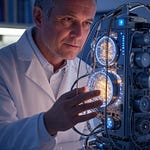Modern biotechnology, with its advances in genetic manipulation and synthetic biology, offers us a fascinating opportunity: the possibility of creating life forms inspired by the fantastical creatures and elements found in iconic literary works like those of Harry Potter or The Lord of the Rings. This fusion between science and imagination could not only enrich art and narrative but also open new doors in practical fields such as medicine, agriculture, and sustainability. Below, we will explore how this could become a reality, some concrete examples, and the implications it entails.
Genetic Manipulation and Synthetic Biology: The Canvas of Imagination
Current biotechnology allows us to modify the DNA of existing organisms or even design entirely new ones from scratch. This means we could draw inspiration from fictional worlds to create life that reflects the wonders of those stories:
- Magical luminescent plants: In the Harry Potter universe, we find plants like the Mandrake or the Whomping Willow, but we could also imagine plants that glow in the dark, reminiscent of the magical atmosphere of Hogwarts. Using genes from bioluminescent organisms, such as certain jellyfish or lanternfish, scientists could design plants that emit their own light, combining aesthetic beauty with possible applications, like low-energy natural lighting.
- Microorganisms producing "potions": Inspired by Rowling's magical potions, we could create synthetic microorganisms capable of producing unique chemical compounds. For example, genetically modified bacteria to synthesize advanced medications or substances that mimic the healing effects of a "healing potion," bringing fantasy into medical reality.
- Reimagined fantastical creatures: Although creating a dragon or an Ent from Tolkien as we know them would be extremely complex, biotechnology could take more modest steps. For example, designing small organisms with features like extreme resistance (inspired by dragons) or hybrid plant-animal tissues (similar to Ents), which could be used in ecological or biotechnological studies.
Practical Applications Beyond Fiction
These creations would not be mere exercises in fantasy; they could have a tangible impact on the real world:
- Medicine: Microorganisms designed to produce bioactive compounds could revolutionize pharmacology, creating treatments inspired by the "magical cures" of fiction.
- Agriculture: Plants modified to be more resistant to pests or extreme conditions, inspired by magical flora, could improve food security.
- Sustainability: Bacteria that degrade pollutants, based on fictional purifying creatures, could help clean damaged ecosystems.
Ethical and Safety Challenges
However, this potential is not without risks. Creating life inspired by fiction raises important questions:
- Ethics: Is it right to play "gods" by designing organisms that do not exist in nature? What rights would these life forms have?
- Safety: If these creations escaped human control or interacted unpredictably with the environment, unforeseen consequences could arise.
- Regulation: It would be essential to establish strict legal frameworks to ensure these innovations are developed responsibly.
A Future of Innovation Inspired by Imagination
Integrating biotechnology with the creativity of works like those of Rowling or Tolkien not only brings us closer to materializing the dreams of fiction but also invites us to rethink the limits of science. By combining human imagination with biotechnological tools, we could be on the brink of a new era where stories not only entertain but inspire real advances that transform the world. From plants that illuminate our cities to microorganisms that cure diseases, biotechnology has the power to turn fantasy into a tangible reality, as long as we do so with care and vision.













Share this post